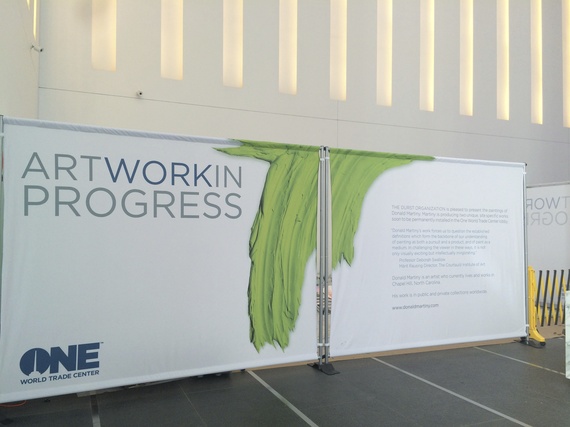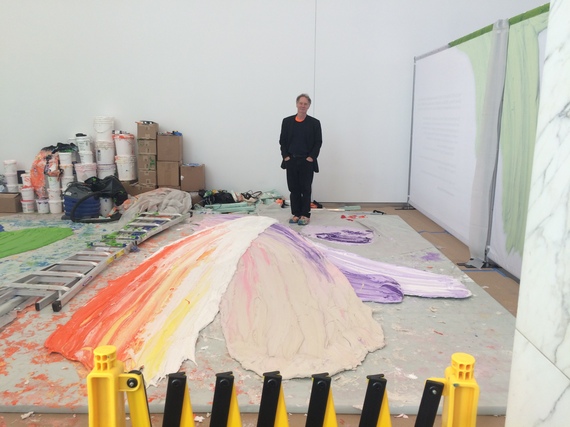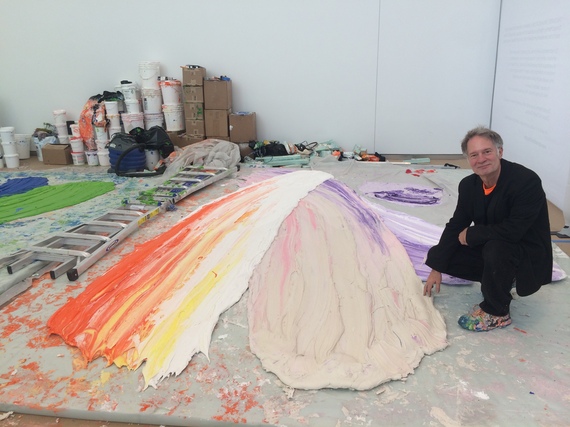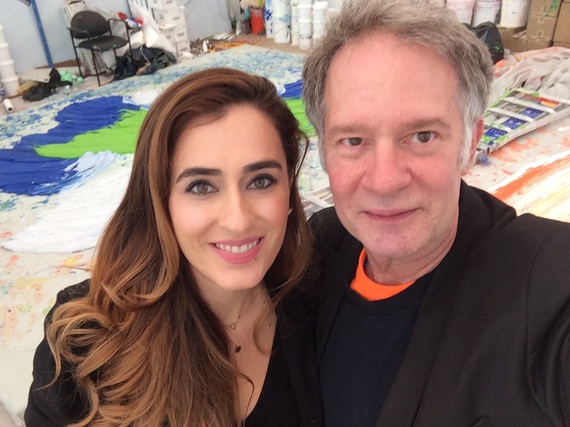I was in New York City in October, on the way to a client meeting at Condé Nast's headquarters at One World Trade, and had an incredible, unexpected experience.
In the south entrance of the One World Trade Center, where a bright, natural light fills the lobby, a large, makeshift wall read, "Artwork in Progress." I peaked around and saw ladders, paint buckets and artist Donald Martiny, dressed in all black with white sneakers splattered in color.
Martiny, who is originally from New York and now lives in North Carolina, was commissioned to create two paintings now permanently installed in the lobby of One World Trade Center. The work commemorates the one-year anniversary of the building's opening on November 3, 2014.
During my visit, Martiny was kind enough to share his process of his large-scale, sculptural paintings. At that time, they were on the floor, still wet with paint.
When I got back to LA, the experience of meeting Martiny, and his unfinished work, stayed with me, so I reached out to ask him a few questions about his work.
Your paintings are really thick. How much paint did you use?
My paintings require a tremendous amount of paint. The paintings at One World Trade Center used something like 60 or 70 gallons of paint each.
They are solid paint. They are not forms with paint on them. If you cut through them the color is through and through.
You mentioned your color choices were specific to a feeling you wanted to create. Can you share more about that?
I wanted the work to relate to the site as much as possible. I spent a lot of time thinking about the building and the location.
Outside is the 911 Memorial where people look down into the powerful and amazing fountains, and look back to the past.
Yet One World Trade Center points up, the building reflects the sky. I wanted the experience of being in the building to be forward-looking and positive.
Also, One World Trade Center sits at the mouth of the Hudson River. I looked at paintings by Frederic Edwin Church and other members of the Hudson River School of landscape painters. I enjoyed the dynamic brushwork and hopeful and positive feeling from the paintings.
I hoped to capture the experience of looking at something uplifting, elegant and majestic the way Church did when he painted Cotopaxi or Niagara Falls.
What are the names of your pieces and how large is the work?
The warm orange and purple painting in the south lobby is titled Lenape and it's 10 x 15 feet. The cool green and blue painting in the North lobby is titled Unami and it's 12 x 12 feet.
How did you choose the names?
The titles are the names of the two languages spoken at the site in lower Manhattan by the indigenous people long before the European settlers arrived.
I have been using the names of extinct languages to title my paintings for the past three or four years. A few years ago I spent time in the Amazon jungle with a small tribe of indigenous people who spoke a language used by less then 200 people. Soon that language, a basic part of their culture and identity will be gone.
I feel that creating a new kind of painting is very much like learning a new language.
I read that the paint used in your pieces took six years to formulate--and with the help of technicians and scientists around the world. What inspired this new kind of paint?
Ha! Yes, that is true. I studied painting at the Art Student's League in NYC and at the Pennsylvania Academy of Art in Philadelphia. I learned how to paint in a very traditional way; drawing from the figure, oil paintings of figures, portraits and landscapes.
I often made small paintings and sketches outdoors. I would take a large canvas or paper and draw a smaller rectangle to define the space that I was going to work in. Inevitably, I would draw or paint outside the lines. I wondered why I kept doing that. I soon realized that the rectangle (like most framed paintings) represented a window or door that the viewer (or artist) would look through to experience the art in a different space or time... sort of like a portal.
I wanted to move away from illusion in my work. I wanted the viewer (and myself) to experience the work in front of the portal, in my own space. I want the work to confront the viewers in their own space. Additionally, I want the work to interact with the space surrounding it.
Once I realized what I wanted to do, make gestural painting without using the rectangular ground or canvas, I needed to invent a paint that could work that way. Acrylic paint is too rubbery and would flop around; oil paint would become too brittle and crack and break.
It took many, many disappointing failures before I found a mixture of material that addressed my needs. I am constantly evolving and improving my materials and processes.
What's next for you?
I have a busy exhibition schedule beginning in January 2016. Additionally, I have a number of long-term projects including a series of sculpture made only from paint.
A selfie with Donald Martiny. In the background, the unfinished painting Unami.



